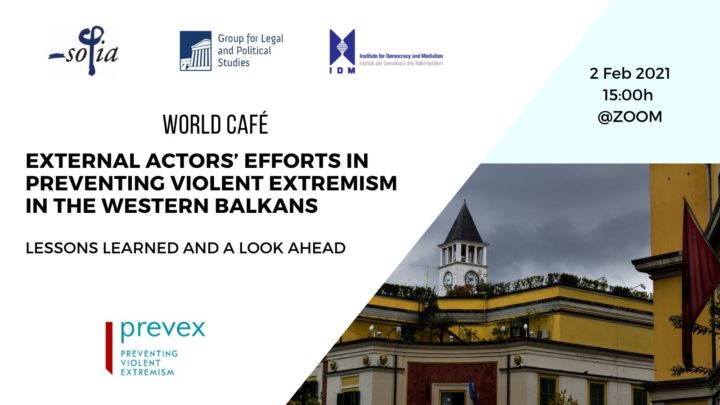What is the role of the EU and other external stakeholders in preventing violent extremism in the Balkans? Presented here are initial findings from Albanian speaking cases – Albania, Kosovo and North Macedonia – in the European Café Debate “External actors’ efforts in preventing violent extremism in the Western Balkans – lessons learned and a look ahead”.
The Centre for Advanced Study Sofia, the Institute for Democracy and Mediation (IDM, Tirana) and the Group for Legal and Political Studies (GLPS, Prishtina) organized an online Café debate to share with a broader public the main insights of the PREVEX Policy Brief on EU and other stakeholder’s prevention strategies towards violent extremism in the Western Balkans (WP5.1), and more particularly those related to Albania, Kosovo and North Macedonia.
Diana Mishkova opened the discussion with a brief overview of the reasons why the Western Balkans have turned into an important part of the project focus. The violent dissolution of Yugoslavia and the ensuing social displacement in the newly emerging countries, combined with other international factors, created what the project conceives as enabling environment, statistically confirmed by the high rate of jihadists – some 350 fighters traveling to Syria and Iraq from Kosovo, BiH and North Macedonia.
The purpose of the Policy Brief that PREVEX scholars presented was to highlight the way foreign stakeholders address these realities, the kind of narratives and measures (hard and soft) they apply, and in return how these are perceived by local actors and communities.
Albania
Leonie Vrugtman’s (IDM) presentation focused on the Albanian case discussing the issue of how the government responded to its citizens joining rebel groups such as ISIS from 2012 to 2014. Various state responses combined with very cooperative and responsive Islamic communities resulted in no Albanian citizens leaving for Syria and Iraq since 2015. International actors contributed decisively to the implementation of various hard and soft P/CVE measures. Despite the successes, Vrugtman noted several deficiencies in her country: P/CVE initiatives lack local ownership; lots of projects but with no persistency and sustainability; appealed for more soft measures; and warned about side-lining far-right extremism.
Kosovo
Arber Fetiu (GLPS) presented the case of Kosovo stating that before 2014, Islamic extremism was not a problem there, however, more than 300 Kosovo Albanians joined the fight after that year. The prevention strategy of Kosovo state actors was developed with the assistance of US and EU as everywhere in the region but a set of social and economic factors – lack of institutional resource – hinder the full scale implementation of the strategy, both hard and soft measures it calls for. Similar to the Albanian case, Arber Fetiu underlined the lack of communication and consultation with the local community and the domination of top-down approach in deploying certain measures and initiatives. Also in Kosovo, the discourse on violent extremism is focused on Islamic extremism neglecting established far-right movements in Northern Kosovo.
North Macedonia
Simeon Evstatiev (CAS) stressed that the Macedonian case is very indicative of religious intersection and presents a potentially fertile ground for detecting eventual reciprocity of extremisms. However, the link between Islamic violent extremism and the growing visibility of far-right rhetoric and activity is rather discursive and displayed on the political level rather than based on real clash and competition on the ground.
Discussion
At the centre of the ensuing discussion was the question of reciprocal extremism: Does Islamic extremism induce far-right extremism and vice versa? Some of the participants expressed their doubt that there was a direct link between these two forms of extremism. In the case of Albania, according to Vrugtman, far-right extremism is very marginal and accidental in its manifestations due to the long tradition of religious coexistence among ethnic Albanians. The case of Kosovo is slightly different in that there are very clear and deep religious lines of division, however, there is no hard evidence that Islamic fundamentalism / violent extremism and far-right radicalism feed each other. They are more dependent on international networks and this is where their incitement mainly comes from.




